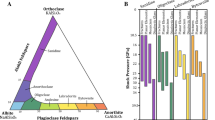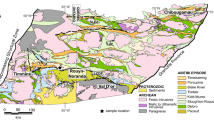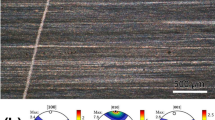Abstract
The chemical widths of grain and phase boundaries in deformed wehrlite (olivine–clinopyroxene; Ol–Cpx) aggregates are characterized by atom probe tomography (APT), a (laser-assisted) field evaporation technique employing time-of-flight mass spectrometry. The wehrlite was deformed to high finite strain in diffusion creep: The effective viscosity measured for the wehrlite is approximately an order of magnitude lower than that of either end-member aggregate; further, phase ordering, in which the spatial density of Ol–Cpx phase boundaries increases with accumulated strain, characterizes the deformation (Zhao et al. in Earth Planet Sci Lett 517:83–94, 2019). The mechanical results imply that the transport properties of the phase boundaries—dictated by their structure and composition—differ from those of grain boundaries. Our APT data show that, indeed, the chemical widths of crystalline Ol–Cpx phase boundaries—3.1–6.6 nm, depending on the element used for their characterization—are up to a factor of two greater than the chemical widths of crystalline Ol–Ol and Cpx–Cpx grain boundaries. Careful statistical analyses of the APT data reveal that the near-boundary compositional profiles of the presented Ol–Cpx phase boundary are consistent with—indeed, evidence for—the rheological model in which diffusion creep is rate-limited by the (mechanism-required) interfacial reactions at the Ol–Cpx phase boundaries. Such an analysis is unavailable by current electron beam/X-ray spectrometry approaches, which have not the requisite spatial precision. APT application to nanometer-scale problems in silicate petrology is challenging, particularly because signal overlap is caused by the evaporation of polyion species. We carefully outline the procedures used to acquire and discriminate the data in order to address the challenges of signal overlap.






Similar content being viewed by others
References
Arzt E, Ashby MF, Verrall RA (1983) Interface controlled diffusional creep. Acta Metall 31(12):1977–1989
Blavette D, Duval P, Letellier L, Guttmann M (1996) Atomic-scale APFIM and TEM investigation of grain boundary microchemistry in Astroloy nickel base superalloys. Acta Mater 44(12):4995–5005
Bons PD, den Brok B (2000) Crystallographic preferred orientation development by dissolution–precipitation creep. J Struct Geol 22(11–12):1713–1722
Budai J, Gauddig W, Sass SL (1979) The measurement of grain boundary thickness using X-ray diffraction techniques. Philos Mag A 40(6):757–767
Bunton JH, Kelly TF, Gribb TT (2010) U.S. patent no. 7,683,318. U.S. Patent and Trademark Office, Washington, DC
Cantwell PR, Tang M, Dillon SJ, Luo J, Rohrer GS, Harmer MP (2014) Grain boundary complexions. Acta Mater 62:1–48
Carter CB, Kohlstedt DL, Sass SL (1980) Electron diffraction and microscopy studies of the structure of grain boundaries in Al2O3. J Am Ceram Soc 63(11–12):623–627
Chakraborty S (2010) Diffusion coefficients in olivine, wadsleyite and ringwoodite. Rev Miner Geochem 72(1):603–639
Cho J, Harmer MP, Chan HM, Rickman JM, Thompson AM (1997) Effect of yttrium and lanthanum on the tensile creep behavior of aluminum oxide. J Am Ceram Soc 80(4):1013–1017
Coble RL (1963) A model for boundary diffusion controlled creep in polycrystalline materials. J Appl Phys 34(6):1679–1682
Cooper RF (2002) Seismic wave attenuation: energy dissipation in viscoelastic crystalline solids. Rev Miner Geochem 51(1):253–290
de Laeter JR, Böhlke JK, De Bièvre P, Hidaka H, Peiser HS, Rosman KJR, Taylor PDP (2003) Atomic weights of the elements. Review 2000 (IUPAC technical report). Pure Appl Chem 75(6):683–800
Detor AJ, Miller MK, Schuh CA (2007) Measuring grain-boundary segregation in nanocrystalline alloys: direct validation of statistical techniques using atom probe tomography. Philos Mag Lett 87(8):581–587
Dohmen R, Milke R (2010) Diffusion in polycrystalline materials: grain boundaries, mathematical models, and experimental data. Rev Miner Geochem 72(1):921–970
Exertier F, La Fontaine A, Corcoran C, Piazolo S, Belousova E, Peng Z, Pedrazzini S (2018) Atom probe tomography analysis of the reference zircon gj-1: an interlaboratory study. Chem Geol 495:27–35
Fisher JC (1951) Calculation of diffusion penetration curves for surface and grain boundary diffusion. J Appl Phys 22(1):74–77
Frost BR, Fyfe WS, Tazaki K, Chan T (1989) Grain-boundary graphite in rocks and implications for high electrical conductivity in the lower crust. Nature 340(6229):134–136
Fujii N, Osamura K, Takahashi E (1986) Effect of water saturation on the distribution of partial melt in the olivine-pyroxene-plagioclase system. J Geophys Res Solid Earth 91(B9):9253–9259
Gault B, Moody MP, Cairney JM, Ringer SP (2012) Atom probe microscopy, vol 160. Springer Science & Business Media, New York
Gottstein G, Shvindlerman LS (2009) Grain boundary migration in metals: thermodynamics, kinetics, applications, 2nd edn. CRC Press, Boca Raton
Gribb TT, Cooper RF (1998) Low-frequency shear attenuation in polycrystalline olivine: Grain boundary diffusion and the physical significance of the Andrade model for viscoelastic rheology. J Geophys Res Solid Earth 103(B11):27267–27279
Hellman OC, Vandenbroucke JA, Rüsing J, Isheim D, Seidman DN (2000) Analysis of three-dimensional atom-probe data by the proximity histogram. Microsc Microanal 6(5):437–444
Herring C (1950) Diffusional viscosity of a polycrystalline solid. J Appl Phys 21(5):437–445
Hiraga T, Anderson IM, Kohlstedt DL (2004) Grain boundaries as reservoirs of incompatible elements in the Earth’s mantle. Nature 427(6976):699–703
Hirth G, Kohlstedt DL (1995) Experimental constraints on the dynamics of the partially molten upper mantle: 2. Deformation in the dislocation creep regime. J Geophys Res Solid Earth 100(B8):15441–15449
Isheim D, Gagliano MS, Fine ME, Seidman DN (2006) Interfacial segregation at Cu-rich precipitates in a high-strength low-carbon steel studied on a sub-nanometer scale. Acta Mater 54(3):841–849
Jamnik J, Raj R (1996) Space-charge-controlled diffusional creep: volume diffusion case. J Am Ceram Soc 79(1):193–198
Kelly TF, Larson DJ, Thompson K, Alvis RL, Bunton JH, Olson JD, Gorman BP (2007) Atom probe tomography of electronic materials. Annu Rev Mater Res 37:681–727
Kingery WD, Bowen HK, Uhlmann DR (1976) Introduction to ceramics, 2nd edn. Wiley, New York
Kliewer KL, Koehler JS (1965) Space charge in ionic crystals. I. General approach with application to NaCl. Phys Rev 140(4A):A1226–A1240
Kohlstedt DL (1990) Chemical analysis of grain boundaries in an olivine-basalt aggregate using high-resolution, analytical electron microscopy. In: Duba AG, Durham WB, Handin JW, Wang HF (eds) The brittle ductile transition in rocks: the heard volume. American Geophysical Union, Washington, pp 211–218
Kondepudi D, Prigogine I (1998) Modern Thermodynamics. In: From heat engines to dissipative structures. Wiley, Hoboken, NJ, p 486
Krakauer BW, Seidman DN (1993) Absolute atomic-scale measurements of the Gibbsian interfacial excess of solute at internal interfaces. Phys Rev B 48(9):6724-6727
Marquardt K, Faul UH (2018) The structure and composition of olivine grain boundaries: 40 years of studies, status and current developments. Phys Chem Miner 45(2):139–172
Miller MK (2006) Atom probe tomography characterization of solute segregation to dislocations. Microsc Res Tech 69(5):359–365
Miller MK, Russell KF, Thompson K, Alvis R, Larson DJ (2007) Review of atom probe FIB-based specimen preparation methods. Microsc Microanal 13(6):428–436
Nabarro FRN (1948) Deformation of crystals by motion of single ions. In: Nooky G (ed) Report on a conference on the strength of solids. Physical Society of London, UK, pp 75–90
Peterman EM, Reddy SM, Saxey DW, Snoeyenbos DR, Rickard WD, Fougerouse D, Kylander-Clark AR (2016) Nanogeochronology of discordant zircon measured by atom probe microscopy of Pb-enriched dislocation loops. Sci Adv 2(9):e1601318
Pommier A, Kohlstedt DL, Hansen LN, Mackwell S, Tasaka M, Heidelbach F, Leinenweber K (2018) Transport properties of olivine grain boundaries from electrical conductivity experiments. Contrib Miner Petrol 173:1–13
Raj R, Ashby MF (1971) On grain boundary sliding and diffusional creep. Metall Trans 2(4):1113–1127
Ricoult DL, Kohlstedt DL (1983) Structural width of low-angle grain boundaries in olivine. Phys Chem Miner 9(3–4):133–138
Saxey DW, Moser DE, Piazolo S, Reddy SM, Valley JW (2018a) Atomic worlds: current state and future of atom probe tomography in geoscience. Scr Mater 148:115–121
Saxey DW, Reddy SM, Fougerouse D, Rickard WD (2018b) The optimization of zircon analyses by laser-assisted atom probe microscopy: insights from the 91500 zircon standard. In: Moser DE, Corfu F, Darling JR, Reddy SM, Tait K (eds) Microstructural geochronology: planetary records down to atom scale. Wiley-Blackwell, UK, pp 293–313
Schmalzried H (1981) Solid state reactions, 2nd edn. Verlag Chemie, Weinheim
Sundberg M, Cooper RF (2008) Crystallographic preferred orientation produced by diffusional creep of harzburgite: effects of chemical interactions among phases during plastic flow. J Geophys Res Solid Earth 113(12):B12208. https://doi.org/10.1029/2008JB005618
Sutton AP, Balluffi RW (1995) Interfaces in crystalline materials. Clarendon Press, Oxford
Tasaka M, Zimmerman ME, Kohlstedt DL, Stünitz H, Heilbronner R (2017) Rheological weakening of olivine + orthopyroxene aggregates due to phase mixing: Part 2. Microstructural development. J Geophys Res Solid Earth 122(10):7597–7612
Tsong TT (1978) Field ion image formation. Surf Sci 70(1):211–233
Valley JW, Cavosie AJ, Ushikubo T, Reinhard DA, Lawrence DF, Larson DJ, Clifton PH, Kelly TF, Wilde SA, Moser DE, Spicuzza MJ (2014) Hadean age for a post-magma-ocean zircon confirmed by atom-probe tomography. Nat Geosci 7(3):219–223
Warren JM, Hirth G (2006) Grain size sensitive deformation mechanisms in naturally deformed peridotites. Earth Planet Sci Lett 248(1–2):438–450
Wheeler J (1992) Importance of pressure solution and Coble creep in the deformation of polymineralic rocks. J Geophys Res Solid Earth 97(B4):4579–4586
Xu Y, Shankland TJ (1999) Electrical conductivity of orthopyroxene and its high pressure phases. Geophys Res Lett 26(17):2645–2648
Yan MF, Cannon RM, Bowen HK (1983) Space charge, elastic field, and dipole contributions to equilibrium solute segregation at interfaces. J Appl Phys 54(2):764–778
Zhang X, Ganguly J, Ito M (2010) Ca–Mg diffusion in diopside: tracer and chemical inter-diffusion coefficients. Contrib Miner Petrol 159(2):175–186
Zhao N, Hirth G, Cooper RF, Kruckenberg SC, Cukjati J (2019) Low viscosity of mantle rocks linked to phase boundary sliding. Earth Planet Sci Lett 517:83–94
Acknowledgements
Prof. Greg Hirth (Brown University) offered lively discussion of aspects of mechanical properties theory. Joseph Bunton (Cameca Instruments, Madison, WI) helped us understand aspects of laser–solid interaction. This work was carried out in part at (a) the Center for Nanoscale Systems, Harvard University (National Science Foundation award number 1541959), and (b) the Central Analytical Facility supported by the University of Alabama. We happily acknowledge very helpful formal reviews by Drs. Steve Reddy and Sandra Piazolo and journal editor Larissa Dobrzhinetskaya. This research was supported financially, in part, through grants from the National Science Foundation Division of Earth Sciences (EAR-1144668, Program in Petrology and Geochemistry; EAR-1620474, Program in Geophysics).
Author information
Authors and Affiliations
Corresponding author
Additional information
Publisher's Note
Springer Nature remains neutral with regard to jurisdictional claims in published maps and institutional affiliations.
Electronic supplementary material
Below is the link to the electronic supplementary material.
269_2019_1045_MOESM1_ESM.png
Supplementary Figure A: Proxigram and 1-D analyses of major and minor element chemistry near the olivine–clinopyroxene phase boundary. Proxigram based on a Ca2+ isosurface created with a 3-nm grid-size smoothing. Delocalization parameters are x = 3.0 nm, y = 3.0 nm and z = 1.5 nm. The upper-left graphs represent total detected atomic species (PNG 384 kb)
269_2019_1045_MOESM2_ESM.png
Supplementary Figure B: Proxigram and 1-D analyses of trace element chemistry near the olivine–clinopyroxene phase boundary. Proxigram based on a Ca2+ isosurface created with a 3-nm grid-size smoothing. Delocalization parameters are x = 3.0 nm, y = 3.0 nm and z = 1.5 nm (PNG 426 kb)
269_2019_1045_MOESM3_ESM.png
Supplementary Figure C: Proxigram and 1-D analyses of major and minor element chemistry near the olivine–olivine grain boundary. Proxigram based on a Ca2+ isosurface created with a 5-nm grid-size smoothing. Delocalization parameters are x = 3.0 nm, y = 3.0 nm and z = 1.5 nm. The upper-left graphs represent total detected atomic species (PNG 397 kb)
269_2019_1045_MOESM4_ESM.png
Supplementary Figure D: Proxigram and 1-D analyses of trace element chemistry near the olivine–olivine phase boundary. Proxigram based on a Ca2+ isosurface created with a 5-nm grid-size smoothing. Delocalization parameters are x = 3.0 nm, y = 3.0 nm and z = 1.5 nm (PNG 414 kb)
269_2019_1045_MOESM5_ESM.png
Supplementary Figure E: 1-D analyses of major and minor element chemistry near the clinopyroxene–clinopyroxene grain boundary. Insufficient chemical gradients exist for proxigram calculations at this interface. Delocalization parameters are x = 3.0 nm, y = 3.0 nm and z = 1.5 nm. The upper-left graph represents total detected atomic species (PNG 273 kb)
269_2019_1045_MOESM6_ESM.png
Supplementary Figure F: 1-D analyses of trace element chemistry near the clinopyroxene–clinopyroxene grain boundary. Insufficient chemical gradients exist for proxigram calculations at this interface. Delocalization parameters are x = 3.0 nm, y = 3.0 nm and z = 1.5 nm (PNG 289 kb)
269_2019_1045_MOESM10_ESM.png
Supplementary Figure J: Selected APT analytical reconstructions from the Cpx–Cpx boundary. The 3-D reconstruction is oriented with the vector normal to the grain boundary within the plane of the page. Al and Ca are enriched at the Cpx–Cpx boundary (PNG 729 kb)
Rights and permissions
About this article
Cite this article
Cukjati, J.T., Cooper, R.F., Parman, S.W. et al. Differences in chemical thickness of grain and phase boundaries: an atom probe tomography study of experimentally deformed wehrlite. Phys Chem Minerals 46, 845–859 (2019). https://doi.org/10.1007/s00269-019-01045-x
Received:
Accepted:
Published:
Issue Date:
DOI: https://doi.org/10.1007/s00269-019-01045-x




